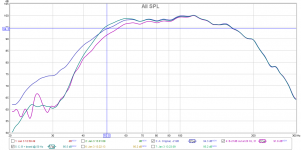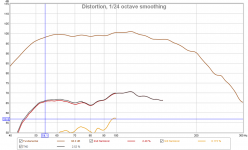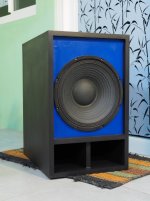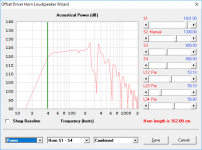regarding the audibility of bass distortion - is that with sine wave? - music? - if the latter, subjectively how does the distortion subjectively manifest itself? darker timbres? - wooly bass ? thud-i-ness?
would you still suggest tuning POC3 TH a bit higher?
would you still suggest tuning POC3 TH a bit higher?
regarding the audibility of bass distortion - is that with sine wave? - music? - if the latter, subjectively how does the distortion subjectively manifest itself? darker timbres? - wooly bass ? thud-i-ness?
would you still suggest tuning POC3 TH a bit higher?
The audible distortion manifested itself at frequencies below Fb (~50Hz), and it was during a swept sine wave test at different SPL levels, which can be particularly hard on vented designs (or any design where the driver is unloaded below a certain frequency). I configured REW to start the sweeps off at 44 Hz and then changed it to 48 Hz for the sweeps at higher power. I still wasn't able to achieve 10% THD in the passband, but I got very close.
I was able to find some temporary stuffing material yesterday afternoon, so I'm going to perform another set of tests today on it, including the filtering suggestion I gave in a previous message.
Hey, I can even make a good recording of it (using the UMM mike) playing back a few tracks. Any suggestions? 🙂
would you still suggest tuning POC3 TH a bit higher?
Yes, if planning to use just one. ~40 Hz tuning on a 12" driver with 5mm Xmax for pro audio use is really pushing it.
I was able to find some temporary stuffing material yesterday afternoon, so I'm going to perform another set of tests today on it, including the filtering suggestion I gave in a previous message.
The results of the filtering look pretty good - see attached. Basically I minimized the 20 Hz and 31 Hz setting, then increased the 50 Hz setting a bit to compensate and add a little extra at that frequency.
I also tried running it again at the maximum volume I was prepared to drive it. My multimeter suggests that 32.2V at 70 Hz and 37.7V at 50 Hz. It survived the playing of some test tracks with lots of low frequency bass (e.g. "Mi Gente") intact without sounding stressed. At peak levels it did lose that "effortless" sound of the POC3 TH alignment though, but that may be due to my "confirmation bias" at work again 🙂
Attachments
That'll be a good little outdoor bass bin with the processing you did. I think the thickness of the cone on these, also help with the perception of it going deeper than it really is. Be sure to let us know how you feel about it after a few good party sessions.
That'll be a good little outdoor bass bin with the processing you did. I think the thickness of the cone on these, also help with the perception of it going deeper than it really is. Be sure to let us know how you feel about it after a few good party sessions.
Interesting you'd mention that. Per the measurement below, the distortion is primarily 2nd order in nature (though at high levels the driver's terminals can be heard buzzing via the vent). We are not sensitive to distortion at bass frequencies, and we are certainly not sensitive to even order distortion at bass frequencies - it can actually make the bass sound "fuller". This might work in this design's favour.
Attachments
Just a minor update - I've finished the first paint job on the POC6 (which of course exposed all the flaws that need to be corrected). I built this as a sort of "reference", but it might actually end up getting some use outside, so I've got to find a way of protecting the MDF from the elements (the occasional beer spill, etc.). Paint and a good mesh grille for the driver should do the job.
The POC6 actually sounds pretty good, with a nice punchy sound with most music. It's about the third time (that I know about) that the MLTL workbook has been used to successfully design a subwoofer (though with a 48 Hz Fb, and a rolloff that starts a bit above 50 Hz, this is more truthfully a bass module than a subwoofer!).
The POC6 actually sounds pretty good, with a nice punchy sound with most music. It's about the third time (that I know about) that the MLTL workbook has been used to successfully design a subwoofer (though with a 48 Hz Fb, and a rolloff that starts a bit above 50 Hz, this is more truthfully a bass module than a subwoofer!).
Attachments
Can also be a part of a DJ monitor setup. What is the bandwidth? Did you do any measurements?
There are some measurements at the link below, but I haven't done any "proper" FR measurements yet. Looks like I'll have to use ground plane measurement for this one, because there ain't no way I'm schlepping this 50 Lb box up my 4 ft. stand for that. From 200 Hz down it's reasonably flat (response slopes off just above 50 Hz), but I am wondering what it's going to be like from about 200 Hz up...
The Subwoofer DIY Page v1.1 - Projects : Proof of Concept #6
That look pretty stable for such a cheap 12" driver. Wonder what it can do with Eminence DELTA PRO 12-450A, i have a few laying around here somewhere.
I am wondering what it's going to be like from about 200 Hz up...
Well, forget it for any use above 200 Hz. It measures reasonably flat (slight hump at 500 Hz), but there's way too much midrange leakage through the vent. This is definitely a 200 Hz and below build.
PA310-8 sounds "too" thick and blurry in an old Karlson K12 vs Kappa12a
do you think a BVR like RCA-Fan's little Hitbox would filter out leakage enough as to allow a good match to horn or midrange on top with PA310?
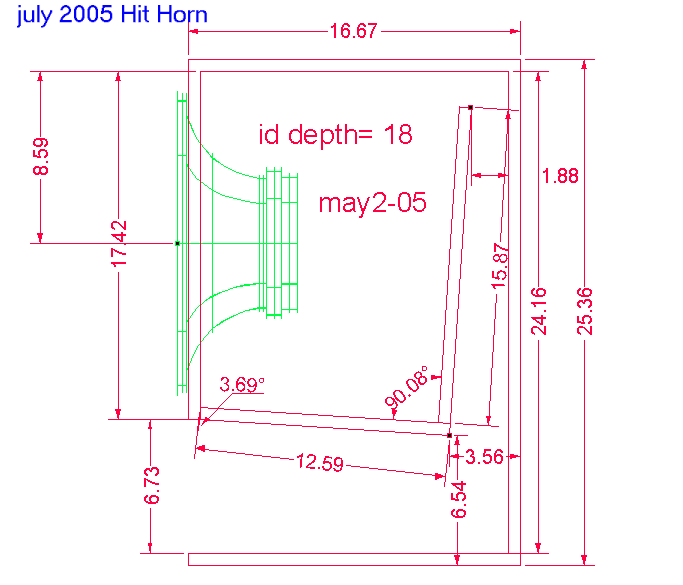
was just thinking about scaling the area on the Boom Unit for my M151
https://i.imgur.com/UjDME2z.jpg
here's a rough 60 liter airspace BVR with 40 liter chamber

do you think a BVR like RCA-Fan's little Hitbox would filter out leakage enough as to allow a good match to horn or midrange on top with PA310?

was just thinking about scaling the area on the Boom Unit for my M151
https://i.imgur.com/UjDME2z.jpg
here's a rough 60 liter airspace BVR with 40 liter chamber

Last edited:
Brian I've been gifted a pair of EV DL18MT drivers and am not equipped to use your workbooks. Could you bust out a design for me? I'm an old TL guy so your POC6 looks interesting. Looking for 40-300 Hz. These were used in the manifold boxes in the 80s-90s.
Thanks
Fred
Thanks
Fred
Last edited:
Brian I've been gifted a pair of EV DL18MT drivers and am not equipped to use your workbooks. Could you bust out a design for me? I'm an old TL guy so your POC6 looks interesting. Looking for 40-300 Hz. These were used in the manifold boxes in the 80s-90s.
Thanks
Fred
I have a possible design, but you're not going to get to 300 Hz with it. More like 150 Hz. If you want to go higher, a simple vented enclosure should do it, but you'd have to compromise on the size/length of the vents to avoid pipe resonances within the passband that you're looking for.
Attachments
The end user wonders if these would work in a TH. He already has PAL12's for smaller gigs but has a pair of mid-high boxes that don't go below 100 hz. For side fill use size matters on stage so that is a factor. Active x/o.
Last edited:
The end user wonders if these would work in a TH.
I doubt. Cone might not be strong enough for that type of use.
- Status
- Not open for further replies.
- Home
- Loudspeakers
- Subwoofers
- Simple bass unit using the Dayton PA310
